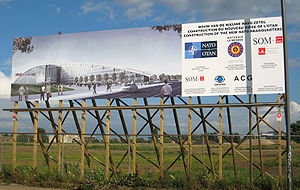 Image by ciao micio via Flickr
Image by ciao micio via FlickrThe Minds Behind Rap News
25 Blogs Every Aspiring Novelist Should Read
More Protein, Less Refined Starch Important for Dieting, Large Study Shows
How Corn Is Expanding Our Waistlines And Crippling Our Health System
Food activist Wayne Roberts calls corn "the most subsidized crop in the world, and it has only negative health consequences." Roberts notes that not only is our food system broken, but our health system too: "We have a health care system that doesn't care about food, and a food system that doesn't care about health."
As a professor in the Department of Environmental Sciences at University of Virginia, Macko knew the two trillion-plus corn plants grown each year in Iowa--300 for every man, woman and child on the planet--had to be going somewhere. Macko estimates after water, the number one component in humans comes from corn. We're essentially walking corn chips.
The problems that come from such a diet are legion, including diet-related chronic diseases such as cancer, cardiovascular diseases, diabetes, and stroke.
 Cover of What to EatHow to Get Your Kids to Eat More Vegetables
Cover of What to EatHow to Get Your Kids to Eat More Vegetables- Link Confirmed Between Sugar-Sweetened Beverages and Type 2 Diabetes
- Want to Have Healthier Shopping Habits? Pay With Cash
- How To Cook Tofu Like the Pros
- Soup of the Week: Vegetable, Beans and Pasta
- Proof: Processed Meats Directly Linked to Cancer, and What to Eat Instead
Changes in Gratitude: Eternal Thanks for a Nonviolent Future
How many of us really have taken all the steps at our disposal to forestall the drivers of climate change, from zeroing our carbon emissions to refraining from the consumption of products responsible for deforestation and mounting waste? Who among us has truly stood resolute against the war machine at every turn, from open and organized tax resistance to educating tirelessly against the fallacies of recruitment? And who has completely disavowed any connection whatsoever with the corporate conglomerate that impose their will on the world? This isn’t an indictment, but more so a statement about the nature of the challenge before us. The array of nonviolent tactics for change at our disposal is vast and always growing, as Gene Sharp has documented.
 Image via WikipediaShame On Austria
Image via WikipediaShame On Austria
Austrian activists face up to 5 years in prison
NATO's Nuclear Doctrines: Omnicidal Weapons and "Vassal States"
Joseph Gerson ( Precis )
In the so-called "new strategic concept," "nuclear weapons remain at the core of NATO doctrine, and an attempt to withdraw an estimated 200 American B-61 nuclear bombs from Europe, a legacy of the cold war, is not mentioned."[1] So much for a new doctrine or for "change that we can believe."
The disastrous recent US election resulted from the confluence of corruptions of our political system and our economic crisis. The environment is reminiscent of the early 1930s, when the Great Depression was fertile ground for the rise of fascism. More optimistic writers are thinking in terms of the U.S. becoming a banana republic.
Because we can't understand NATO's nuclear doctrines – old and new – without understanding how NATO fits into Washington's global strategies, I will begin by talking about U.S. geostrategic thinking and will then turn to the history, roles and specifics of U.S.-NATO nuclear doctrines.
NATO has always been about more than containing Moscow. Like the unequal treaties of European colonialism in Asia, NATO has been a fig leaf, providing a degree of legitimacy for the continuing US military occupation and related US political influence across western Eurasia.
The collapse of the Soviet Union eliminated NATO's Cold War raison d'etre and undermined rationales for the foreign deployment of hundreds of thousands of US warriors.
Brzezinski's "The Grand Chessboard" was a primer explaining that the Empire's most essential geostrategic requirement is dominance of the Eurasian heartland, and that the U.S. must have footholds on Eurasia's western, southern and eastern peripheries.
Brzezinski explained that first rank US allies are "vassal states," whose elites share in imperial privilege.
Russia's military power continues to decline. As the Albright Report concedes, Europe faces no immediate threat of a foreign invasion. With the economic crisis, there will be no appetite to implement Washington's demands for greater European military spending.
Some NATO forces will continue to fight in Afghanistan as the U.S. pursues its doomed strategy of deadly, Vietnam-style coercive diplomacy. But the ambition to transform NATO into a global alliance committed to "out of area operations," in part to contain China, perished in the Afghan quagmire.
 Image via Wikipedia Unaware of the deadly connection between foreign military interventions and the preparations for and threats to initiate nuclear war, most US people think of the US nuclear arsenal only in terms of deterrence, an approach that some in the Pentagon have said "has never been our doctrine."
Image via Wikipedia Unaware of the deadly connection between foreign military interventions and the preparations for and threats to initiate nuclear war, most US people think of the US nuclear arsenal only in terms of deterrence, an approach that some in the Pentagon have said "has never been our doctrine."Noam Chomsky explained "we have succeeded in sufficiently intimidating anyone who might help protect people who we are determined to attack."
Who believes that nuclear threats deter non-state terrorists or do anything but encourage non-nuclear states to emulate NATO by building deterrent nuclear arsenals of their own? The 180 or so genocidal nuclear weapons currently based in Europe are to remain here indefinitely.
Iran's nuclear program is probably more like Japan's than Pakistan's. By becoming a near-nuclear power, it has enhanced its regional influence. Should it produce nuclear weapons, it would spark a regional nuclear arms race that would further undermine Iran's security.
 Image via Wikipedia
Image via WikipediaCivil disobedience against NATO
20 November 2010
About 50 activists from Portugal, Spain, Finland, Belgium, Canada, France, Germany, the Netherlands and Poland blocked one of the access roads for participating delegates and government officials to the summit. With chains and locks attached to their bodies they try to delay the summit from taking place in order to disturb NATO' s future planning.
03 Nov 2010
South Korea's Prosperity Defense -WSJ
North Korea's unprovoked attack Tuesday on South Korean civilians is causing justifiable consternation among leaders in Seoul, Tokyo, Washington and (perhaps) Beijing. One group of people, however, has seemed less concerned: investors.
( 'Unprovoked' Uh-huh. China doesn't seem to think so. War Games in disputed territory in an 'unfinished war' aren't 'provocative', are they ? Noooo...of course not.
To see the article you have to pay for the content. Neeeeext! )
Hill 303 Massacre
Killing of enemy who were wounded and helpless was done by all sides in the Korean War, and in all wars. In the desperation of combat, particularly when there is no provision for caring for wounded and no troops to spare to guard them, this sometimes is a practical necessity, however horrible the idea.On the east side of the Chosin Reservoir, CCF 80th Division troops killed about 300 helpless men from the US 31st Regimental Combat Team. Almost all the men were wounded, who had been packed like sardines into trucks or trailers. Abandoned by 3-31, the rear guard during the RCT's precipitous dash for safety with the Marines at Hagaru-ri, the wounded were trapped at a fire block. They were mostly killed by thermite grenades, thrown into the halted vehicles. A hideous death.
Hundreds of other 31RCT wounded, left behind because of limited space in the trucks, presumably met a similar fate.
The CCF didn't take the wounded American soldiers prisoner, and then murder them. They were caught up in an assault, were ill-equipped to care for hundreds of wounded prisoners, were facing possible counter-attack by our formidable 1st Marine Division, and just killed the prisoners out of hand, during battle. The Marines also killed many CCF soldiers who were wounded, or dying from the terrible cold, during their fight-out from Chosin. To most soldiers, the difference between killing during the peril of combat and murder when safe from retribution, is enormous and unforgiveable.
( Sidebar : I don't seem to have any on hand at the moment...but accounts where Korean civilians were slaughtered in the thousands by coalition forces are online as well...just not particularly accessible to Search. Funny about that. )
Korean Soldiers in WW2 German Army
Nisei and Black Soldiers Recall WWII, Korean Conflict
For two segregated units in the U.S. military – one made up of nisei, the other black Americans – fighting against fascism in Europe linked their experiences in remarkable ways. Their units ended up depending on each other so much that they literally became “blood brothers.”
When the segregated Japanese American units of the 100th and 442nd battalions needed blood transfusions, it was taken from the segregated black 92nd division medical component. As a result, many Japanese Americans took black American blood to save their lives.Retired U.S. Army Colonel Harold Montgomery, a black officer, spoke of these experiences alongside Colonels Jimmi Kanaya and Yeiichi Kelly Kuwayama at a recent panel at the Smithsonian National Museum American History Behring Center. The event was sponsored by the Smithsonian Asia Pacific American Program, the National Japanese American Memorial Foundation and the Japanese American Veterans Association (JAVA).
Panelists describe how they had fought two wars: one overseas against fascism and concentration camps, and one at home against prejudice and discrimination. These colored American soldiers faced harsh, racist practices during World War II. It was only during the Korean War that Jim Crow units became integrated.
The 442nd Regimental Combat Team wanted to prove their loyalty to the government, even while all Japanese living on the West Coast of the United States were interned in ten military-run camps in the U.S. Those who enlisted were drawn from Hawai’i and the mainland, including many volunteers from internment camps. Despite huge casualties, they garnered over 18,000 individual awards, including 21 Medals of Honor and seven Presidential unit citations.
Rod McLeod’s Political Experiment: Can you win without money?eb18sw ,m2bbbbbbbp[-dp0f










No comments:
Post a Comment